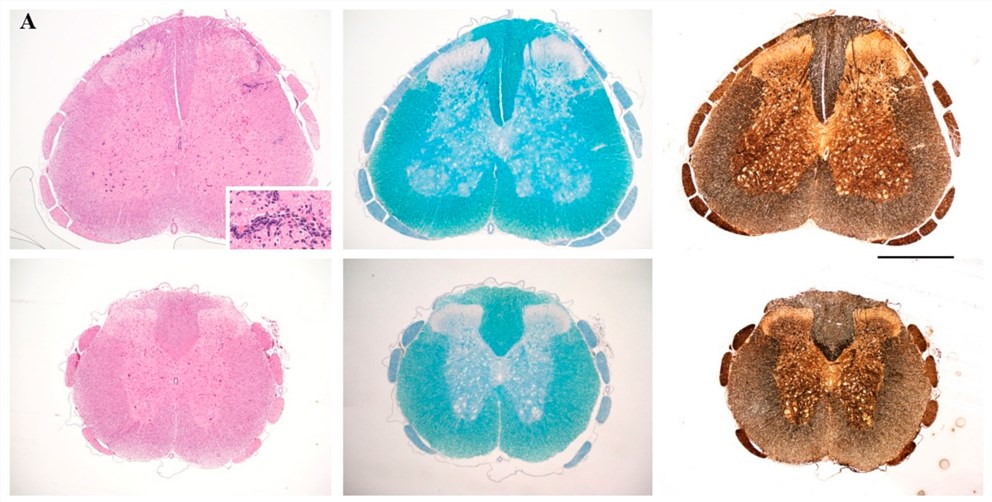MBP induced EAE Rat Model
Experimental Allergic Encephalitis (EAE) is a well-established animal model of MS, that resembles specific features similar to histopathology and neurobiology in humans. MBP-induced EAE model has been an effective tool for the study of acute CNS inflammation. At Creative Biolabs, we offer rat EAE models induced with myelin basic protein (MBP) and a number of endpoints for the preclinical evaluation of potential therapeutics.
Introduction of MBP
MBP is a protein believed to be important in the process of myelination of nerves in the nervous system. Interest in MBP has centered on its role in demyelinating diseases, in particular, MS. Studies have shown a role for antibodies against MBP in the pathogenesis of MS and that inoculating an animal with MBP to generate an immune response against it increases blood-brain barrier permeability, allowing immune cells to enter the brain. To date, MBP has become a major protein of central nervous system myelin which can induce experimental autoimmune encephalomyelitis (EAE) in susceptible laboratory animals, such as Lewis rats. MBP activates autoreactive T-cells that are responsible for CNS inflammation and demyelination, eliciting diseases that display symptoms similar to MS in humans.
Model Description
Although mice remain the most commonly employed animal species in EAE model creation, rat EAE models have contributed a lot to the study of the pathology of MS. For induction of EAE, the Lewis rats are immunized with MBP and Mycobacterium tuberculosis (MT) emulsified in incomplete Freund's adjuvant (IFA) and phosphate buffered saline (PBS), injected in the hind footpads. Alternatively, animals can be immunized with MBP in Freund's adjuvant, injected subcutaneously into the sub-plantar region of the hind paw. MBP-induced EAE in the Lewis rat model typically results in acute paralysis where there is severe CNS inflammation with little or no demyelination and resistance to the further development of EAE. And just because demyelination is not a prominent feature of the disease that rat MBP-induced EAE model is less often used. However, there is no doubt that the model is useful for the study of acute CNS inflammation and pathology of MS.
 Fig.1 Neuropathological analysis of spinal cord sections taken on day 17 following immunization, from representative non-vaccinated control rats (top) and rats vaccinated. Sections were stained with H&E for inflammation (left panels), Luxol Fast Blue for myelin (central panels), and Bielschowsky's silver stain for axons (right panels). (Emmanouil et al. 2018)1, 2
Fig.1 Neuropathological analysis of spinal cord sections taken on day 17 following immunization, from representative non-vaccinated control rats (top) and rats vaccinated. Sections were stained with H&E for inflammation (left panels), Luxol Fast Blue for myelin (central panels), and Bielschowsky's silver stain for axons (right panels). (Emmanouil et al. 2018)1, 2
Features of MBP-Induced EAE Rat Model
- This model is a self-limiting and acute model with little or no demyelination.
- It is characterized by infiltration of mononuclear cells to the cervical spinal cord and formation of foci.
- Therapeutic properties of new drugs and formulations (both preventive and curative) can be evaluated using this model.
Assessments
Rats are weighed and assessed daily for clinical signs. CNS tissues are collected and processed for standard histopathological analyses and inflammation can be visualized by staining with hematoxylin-eosin (H&E). Moreover, cytokine levels such as IFN-γ, IL-4, IL-6, IL-17, and TGF-β can be measured by ELISA. Collectively, Creative Biolabs provides various model assessments including but not limited to:
- Body weight
- EAE scoring
- Cytokine measurements
- Demyelination and cell infiltration in CNS
- Biomarker analysis
- PK sampling
Creative Biolabs also offers other EAE rodent models you may be interested in:
The comprehensive battery of rodent neurological disease models is listed in the chart below for your review:
With highly-qualified and motivated staff as well as years of experience in innovative drug discovery and development, Creative Biolabs offers reliable, high-quality, and fast services to our clients to boost their studies. Contact us to discuss your specific needs and enjoy the great value of our services.
References
- Emmanouil, M.; et al. A cyclic altered peptide analogue based on myelin basic protein 87–99 provides lasting prophylactic and therapeutic protection against acute experimental autoimmune encephalomyelitis[J]. Molecules. 2018, 23(2): 304.
- under Open Access license CC BY 4.0, without modification.
For Research Use Only.
